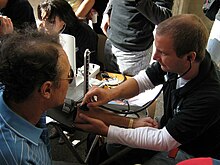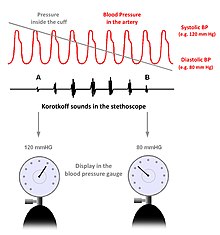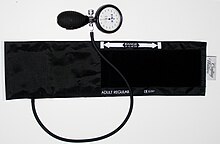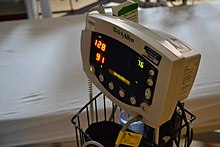Sphygmomanometer
A sphygmomanometer (
A sphygmomanometer consists of an inflatable cuff, a measuring unit (the mercury manometer, or aneroid gauge), and a mechanism for inflation which may be a manually operated bulb and valve or a pump operated electrically.
Types
Both manual and digital meters are currently employed, with different trade-offs in accuracy versus convenience.
Manual
A stethoscope is required for auscultation (see below). Manual meters are best used by trained practitioners, and, while it is possible to obtain a basic reading through palpation alone, this yields only the systolic pressure.
- Mercury sphygmomanometers are considered the gold standard. They indicate pressure with a column of mercury, which does not require recalibration.[2] Because of their accuracy, they are often used in clinical trials of drugs and in clinical evaluations of high-risk patients, including pregnant women. A frequently used wall mounted mercury sphygmomanometer is also known as a Baumanometer.[3]
- Aneroid sphygmomanometers (mechanical types with a dial) are in common use; they may require calibration checks, unlike mercury manometers. Aneroid sphygmomanometers are considered safer than mercury sphygmomanometers, although inexpensive ones are less accurate.[4]A major cause of departure from calibration is mechanical jarring. Aneroids mounted on walls or stands are not susceptible to this particular problem.
Digital
Digital instruments may use a cuff placed, in order of accuracy[12] and inverse order of portability and convenience, around the upper arm, the wrist, or a finger.[13] Recently, a group of researchers at Michigan State University developed a smartphone based device that uses oscillometry to estimate blood pressure.[14][15] The oscillometric method of detection used gives blood pressure readings that differ from those determined by auscultation, and vary according to many factors, such as pulse pressure, heart rate and arterial stiffness,[16] although some instruments are claimed also to measure arterial stiffness, and some can detect irregular heartbeats.
Operation

In humans, the cuff is normally placed smoothly and snugly around an upper arm, at roughly the same vertical height as the heart while the subject is seated with the arm supported. Other sites of placement depend on species and may include the flipper or tail. It is essential that the correct size of cuff is selected for the patient. Too small a cuff results in too high a pressure, while too large a cuff results in too low a pressure. For clinical measurements it is usual to measure and record both arms in the initial consultation to determine if the pressure is significantly higher in one arm than the other. A difference of 10 mmHg may be a sign of coarctation of the aorta. If the arms read differently, the higher reading arm would be used for later readings.[17] The cuff is inflated until the artery is completely occluded.
With a manual instrument, listening with a
Digital instruments use a cuff which may be placed, according to the instrument, around the upper arm, wrist, or a finger, in all cases elevated to the same height as the heart. They inflate the cuff and gradually reduce the pressure in the same way as a manual meter, and measure blood pressures by the oscillometric method.[5]

Significance
By observing the mercury in the column, or the aneroid gauge pointer, while releasing the air pressure with a control valve, the operator notes the values of the blood pressure in mmHg. The peak pressure in the arteries during the cardiac cycle is the systolic pressure, and the lowest pressure (at the resting phase of the cardiac cycle) is the diastolic pressure. A stethoscope, applied lightly over the artery being measured, is used in the auscultatory method. Systolic pressure (first phase) is identified with the first of the continuous Korotkoff sounds. Diastolic pressure is identified at the moment the Korotkoff sounds disappear (fifth phase).
Measurement of the blood pressure is carried out in the diagnosis and treatment of hypertension (high blood pressure), and in many other healthcare scenarios.
History

The sphygmomanometer was invented by
Etymology
The word sphygmomanometer uses the
Most sphygmomanometers were mechanical gauges with dial faces, or mercury columns, during most of the 20th century. Since the advent of electronic medical devices, names such as "meter" and "monitor" can also apply, as devices can automatically monitor blood pressure on an ongoing basis.
References
- ^ PMID 341169.
- ^ "Comparing Mercury and Aneroid Sphygmomanometers". Sustainable Hospitals / Lowell Center for Sustainable Production. 2003. Retrieved 23 February 2015.
- ^ a b "Turning Mercury Into Solid Gold". The New York Times. 27 March 2005. Retrieved 5 July 2018.
- ^ Misrin J. "Aneroid Sphygmomanometer: A Battle for Safer Blood Pressure Apparatus". Archived from the original on 10 August 2015. Retrieved 27 February 2012.
- ^ a b "Oscillometry, Explanation of oscillometric detection in Medical Electronics, N Townsend, p48-51" (PDF). Archived from the original (PDF) on 22 May 2013. Retrieved 10 February 2013.
- ^ "Oscillometric Method - Methods of Blood Pressure Measurement - Measurement of Blood PressureMethods of Blood Pressure Measurement -". www.severehypertension.net. 22 December 2007. Retrieved 13 April 2017.
- ^ Can we trust automatic sphygmomanometer validations? Turner MJ. Journal of Hypertension. 28(12), December 2010, pp. 2353–2356 .
- PMID 18648356.
- ^ Sphygmomanometer calibration--why, how and how often? Turner MJ1, Speechly C, Bignell N. Australian Family Physician. October 2007; 36(10):834-838.
- PMID 23222878.
- S2CID 3952069.
- S2CID 6100566.
- ^ "Blutdruckmessgerät - Handgelenk - Blutdruckmessgerät - Test" (in German). Blutdruckmessgeraet-vergleich-test.de. Retrieved 27 September 2016.
- PMID 29515001.
- PMID 30177793.
- PMID 12055403.
- PMID 23914007.
- ^ U.S patent 1594039 Manometer
- ^ Harper D. "sphygmomanometer". Online Etymology Dictionary.
- ^ Harper D. "manometer". Online Etymology Dictionary.
- Perseus Project.
External links
- US patent 1089122, Francis Ashley Faught, Charles J Pilling, "Apparatus for measuring and indicating blood-pressure", issued 1914-03-03
- US patent 1594039, William A Baum, "Manometer", issued 1926-07-27
- US patent 2560237, R. H. Miller, "Sphygmomanometer", issued 1951-07-10
- US patent 6752764, Man S. Oh, "Pocket sphygmomanometer", issued 2004-06-22




